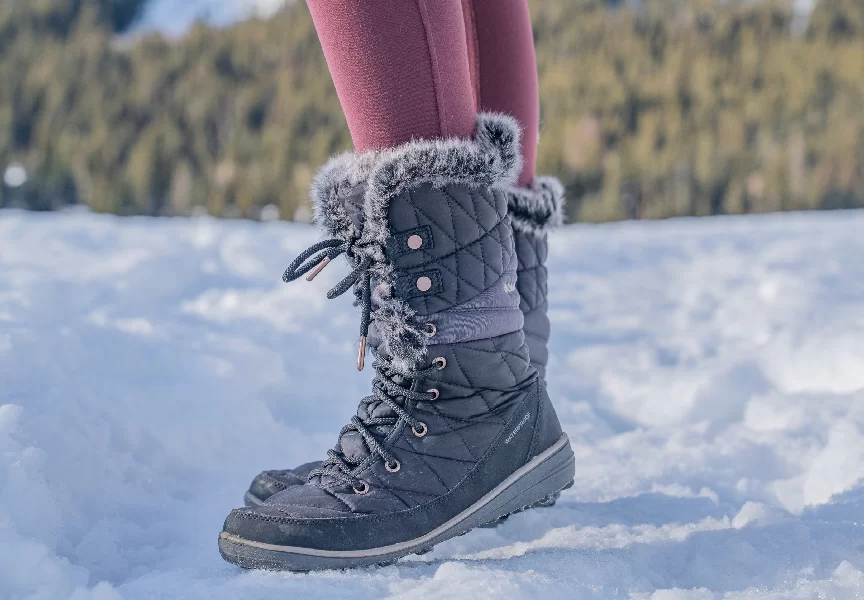
Introduction:
When winter arrives, finding the perfect pair of boots becomes essential for women to stay warm, comfortable, and stylish in cold and snowy conditions. However, with a wide range of options available, choosing the right winter boots can be overwhelming. In this blog post, we will guide you through the key factors to consider when selecting winter boots for women, ensuring you find the ideal combination of warmth, durability, and style to conquer the winter season with confidence.
- Insulation:
One of the most critical factors when choosing winter boots is insulation. Look for boots with proper insulation to keep your feet warm in cold temperatures. Common insulation materials include Thinsulate, fleece, or shearling lining. These materials provide excellent insulation while maintaining breathability. Choose insulation levels based on your climate and intended use. Warmer boots are suitable for extremely cold conditions, while lighter insulation may be appropriate for milder winters. - Waterproofing:
Winter often brings snow, slush, and wet conditions. It’s crucial to choose boots that offer waterproof or water-resistant properties to keep your feet dry. Look for boots made with waterproof materials like Gore-Tex or treated leather. Seam-sealed construction also enhances waterproofing. Waterproof boots ensure your feet stay dry, preventing discomfort and potential health issues. - Traction and Grip:
Walking on icy and slippery surfaces is a common challenge during winter. To avoid slips and falls, prioritize boots with excellent traction and grip. Look for boots with rubber soles featuring deep treads or lugs. This design provides a secure grip on various surfaces, including snow, ice, and wet pavements. Boots with an anti-slip outsole or traction-enhancing technologies like Vibram can significantly improve stability and safety. - Height and Coverage:
Consider the height and coverage of the boots based on the conditions you’ll be facing. Higher boots offer better protection against snow, slush, and cold air, keeping your feet and lower legs warm. Look for boots that extend above the ankle or even mid-calf for added coverage. Additionally, consider boots with adjustable features such as laces or buckles to ensure a snug fit and prevent snow from entering the boots. - Warmth-to-Weight Ratio:
Finding a balance between warmth and weight is crucial for optimal comfort. Look for boots that provide sufficient insulation without being overly heavy or bulky. Advanced insulation materials like Thinsulate offer excellent warmth-to-weight ratio, providing insulation without adding unnecessary bulk to the boots. Lightweight boots allow for easier movement and prevent fatigue during long walks or outdoor activities. - Boot Construction:
The construction of winter boots affects their durability and overall performance. Look for boots with sturdy construction and reinforced seams. Double or triple stitching enhances durability and longevity. Consider boots with a supportive shank or midsole for added stability and arch support. A well-constructed boot will withstand the rigors of winter and provide long-lasting comfort. - Style and Versatility:
While functionality is important, style and versatility also play a role in choosing the right winter boots. Look for boots that align with your personal style and can be easily paired with various outfits. Classic designs and neutral colors offer versatility and ensure your boots remain in style for years to come. Additionally, consider features like removable liners or faux fur detailing that allow for customization and adaptability to different weather conditions. - Fit and Comfort:
Choosing winter boots with the right fit is crucial for maximum comfort. Consider the width, arch support, and toe box space to ensure a comfortable fit for your feet. Boots should provide enough room for thick socks or additional layering without feeling too tight or constricting. Look for boots with cushioned insoles or removable footbeds for added comfort and the option to replace them if necessary. - Brand Reputation and Reviews:
Research reputable brands that are known for their quality winter boots. Consider brands that have a reputation for durability, comfort, and performance in cold weather conditions. Read customer reviews to gain insights into the boots’ fit, warmth, and overall satisfaction. Pay attention to feedback regarding sizing, as some brands may have variations. A reliable brand often provides detailed information about their products’ features, materials, and technologies, helping you make an informed decision.
Conclusion:
Choosing the right winter boots for women requires careful consideration of factors such as insulation, waterproofing, traction, height and coverage, warmth-to-weight ratio, boot construction, style and versatility, fit and comfort, as well as brand reputation and reviews. By evaluating these factors and aligning them with your specific needs, you can find winter boots that keep your feet warm, dry, and comfortable while complementing your personal style. Invest in high-quality boots that will withstand the winter elements and provide reliable performance season after season.



